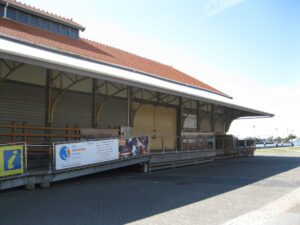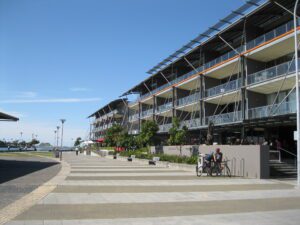THE CINDERELLA CITY
Snapshot 1991 Newcastle, NSW

“In a feature article for the local daily broadsheet newspaper The Newcastle Herald, journalist Terry Smyth (1991, p16) uses the phrase ‘The Cinderella City’ to describe the plight or at least the perceived plight of Newcastle at this time. “Newcastle has a chip on its shoulder … a legacy of decades of hard knocks and of being labelled a dirty coal town.This despondent city”, he suggests “desperately wants to be noticed. Not as a mill town … and certainly not as a quaint backwater, but as a city with distinct lifestyles, problems, resources, advantages and dreams … A city with a soul.” (Stevenson 1999).
A young phd student at the time (Deborah Stevenson) captured the political power that was focused on the old port good yard area of Newcastle harbour and was one of the first to track its amazing transformation and the agendas at work at the time. In her later seminal paper ‘Reflections of a Great Port City’ (1999, p108) she brings to life the power of state led manifestation brought to bear in the new vision for the old port on the Honeysuckle lands. The Building Better Cities nation building programme at the time included a $100m seed fund to activate the precinct.
But money wasn’t enough as it turns out, for the precinct to actually be activated, required an understanding of not only property markets but the political and other forces at work.
Snapshot 2015 Newcastle’s Honeysuckle Precinct

Honeysuckle is a world recognised example of gentrification of a prior port historical area into a mixed use precinct which houses harbourside restaurants, where one can eat around the world whilst gargantuan vessels ply the harbour almost within reach. It houses both commercial and government uses and has a burgeoning modern apartment based population.
To reveal the most recent history of the precinct and to bring the story to life since Deborah Stevenson surveyed the shorelines of Honeysuckle, Dr Jonathan Drane completed a four year research project on dormant cityscapes across Australia with a case study on Honeysuckle.
The case study is included in his doctoral publication see publications page and includes a detailed chronology and timeline of the catalysts and forces at work to create the exciting new precinct.
Jonathan reveals that there is more to revitalising a public land release than understanding of property markets, economics and politics, but how these forces move in what he calls ‘windows of alignment’ where new buildings are proliferated in ‘spasms’.
Read Jonathan’s Case Study on Honeysuckle by going to the following link, opening the doctorate publication and going to chapter 10.
Link to UNSW Library for Published Doctorate
Honeysuckle Newcastle Cinderella City
PRD article.
Case Study Newcastle- Honeysuckle Precinct 2013
Extract from Jonathan Drane’s thesis ‘The Seed in the Cityscape”:
A study of the proliferation of buildings in the Honeysuckle Precinct Newcastle, Australia
Newcastle is a regional city 160km north of Sydney, which has enjoyed a rich history as a major Australian port, providing outlet for coal and its processing into steel, from the Hunter Valley region. Leading up to the early 1990’s, Newcastle suffered from slow economic growth and the decline of some of its key port functions. The result was the obsolescence of large tracts of the former port foreshore area called the Honeysuckle Precinct. With the advent of the federal Building Better Cities Programme in the early 1990’s, the precinct was awarded funding support to stimulate urban renewal and development . The Honeysuckle Development Corporation was formed (and later subsumed by the Hunter Development Corporation) and acted as a catalyst agent of change through the conceptualisation of the precinct, and its implementation by land release to private parties.
The result of this ongoing stimulation over 20 years until today has seen the foreshore change and grow into a popular mixed entertainment and tourist precinct, with related hotels, apartments and restaurants. The method of stimulation of these numerous developments was predominantly by the release of obsolete land parcels to private developers, the proponents of which would be chosen based on conceptual and commercial criteria. A public private partnership of sorts, the precinct has moved vastly from its port functions but is still set in the historical landscape of this major port city.
As with the Townsville case studies, the focus of the case study is the proliferation of buildings from obsolete settings, through development stimulation both public and private. The study aims to reveal the catalytic nature of what is termed the ‘property development mechanism’, which works in waves and at alignments of certain forces and factors.
Dr Jonathan Drane
Read this article as a pdf:
